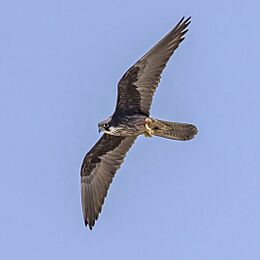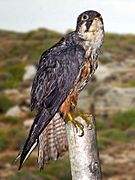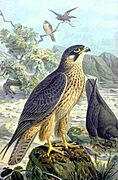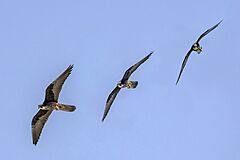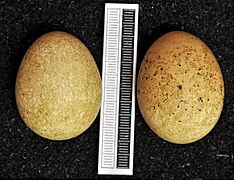Eleonora's falcon facts for kids
Quick facts for kids Eleonora's falcon |
|
|---|---|
|
|
|
| Over the cliffs near Episkopi in Cyprus | |
| Conservation status | |
| Scientific classification | |
| Genus: |
Falco
|
| Species: |
eleonorae
|
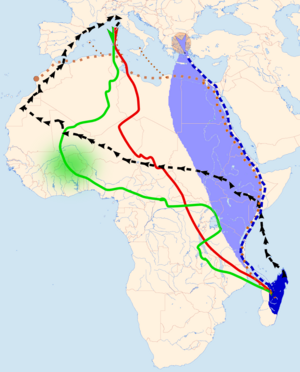 |
|
| Migration routes of Eleonora's falcon | |
The Eleonora's Falcon (Falco eleonorae) is a cool medium-sized bird of prey. It's part of a group of similar falcons called 'hobbies'. Some people think the Sooty Falcon is its closest relative.
This falcon is named after Eleanor of Arborea. She was a queen and hero from Sardinia. In 1392, she made rules to protect the nests of hawks and falcons. This was a very early way to protect wildlife! The name falco comes from a Latin word meaning 'sickle'. This refers to the bird's sharp claws.
Contents
What Does Eleonora's Falcon Look Like?
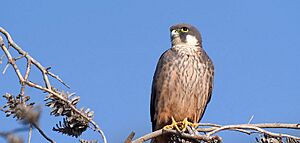
The Eleonora's Falcon is a bird of prey. It is about 36 to 42 centimeters (14 to 17 inches) long. Its wings can spread out 87 to 104 centimeters (34 to 41 inches) wide. It looks like a big Eurasian hobby or a smaller, thin peregrine falcon. It has long, pointed wings, a long tail, and a slim body.
Different Color Types
These falcons come in two main colors, called 'morphs'. The dark morph is all sooty brown. It has black feathers under its wings. The light morph looks more like a young Eurasian hobby. It has lighter, buff-colored feathers on its belly. You can also see the difference between its black underwing feathers and the lighter base of its flight feathers. Young birds also look like big young hobbies. Their light bellies stand out against their darker wingtips. The falcon's call sounds like "kek-kek-kek".
Where Do Eleonora's Falcons Live?
This bird breeds on islands in the Mediterranean Sea. Many of them breed off Greece. About two-thirds of all Eleonora's Falcons breed there! They also live in Cyprus, the Canary Islands, Ibiza, and near Spain, Italy, Croatia, Morocco, and Algeria.
A place called Tilos in Greece is very important. About 10% of the world's Eleonora's Falcons breed there. Researchers found 650 pairs of these birds breeding on Tilos. Sometimes, they are seen further north than their usual range. They also live on the coasts of Madagascar and Mozambique.
Amazing Migration Journey
Eleonora's Falcons are long-distance travelers. They spend their winters in Madagascar. Scientists recently found out their exact migration path. They fly inland across the African continent. Before, people thought they flew along the coast. They believed the falcons flew to Suez and then south along the Red Sea.
However, new satellite tracking shows a different path. Spanish and German researchers tracked these birds. They fly across the Sahara Desert and through rainforests. Then they reach Kenya and Mozambique. One falcon flew up to 9,000 kilometers (5,600 miles) on a single trip!
How Eleonora's Falcons Hunt and Breed
These falcons eat large insects, like dragonflies. They catch them with their claws and eat them while flying. They have also been seen catching small birds. What's amazing is that they sometimes keep these birds alive! They remove their flight feathers. Then they feed them to their young, sometimes days later. This is very rare for a bird species. Sometimes, they also eat bats.
Unique Breeding Season
Eleonora's Falcons breed later in the year, in late summer. This is because they are special hunters of migrating birds. Many birds pass through the Mediterranean islands at this time. The falcons catch small birds in flight. They use their speed and amazing flying skills. They often fly along coastal cliffs. They watch for tired birds arriving from their long journeys.
During a study in Mogador Island, Morocco, researchers saw something unique. Eleonora's Falcons were putting live prey into rock cracks. They would save them to eat later! This falcon is special because it breeds in early autumn. It feeds its chicks with the many migrating birds available then. It is also one of the few falcon species that forms breeding colonies. They build their nests on coastal cliffs. A female falcon can lay up to four eggs.
Gallery


